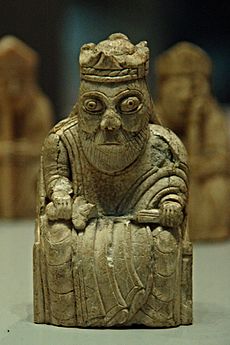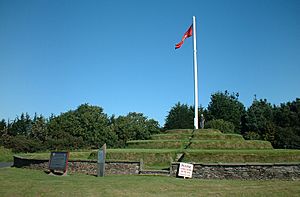Guðrøðr Rǫgnvaldsson facts for kids
Quick facts for kids Guðrøðr Rǫgnvaldsson |
|
|---|---|
| King of the Isles | |
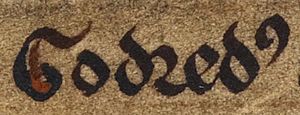
Guðrøðr's name as it appears on folio 42v of British Library Cotton Julius A VII (the Chronicle of Mann): "Godredus".
|
|
| Died | 1231 Lewis and Harris |
| Issue | Haraldr Guðrøðarson |
| House | Crovan dynasty |
| Father | Rǫgnvaldr Guðrøðarson |
Guðrøðr Rǫgnvaldsson (died 1231), also known as Guðrøðr Dond, was a powerful ruler of the Kingdom of the Isles in the 1200s. He was part of the Crovan dynasty, a family that ruled the Isles for a long time. Guðrøðr was the son of Rǫgnvaldr Guðrøðarson, King of the Isles.
The Crovan dynasty often had conflicts over who should be king. This family feud lasted for three generations and greatly affected Guðrøðr's life. His mother was Rǫgnvaldr's wife, who was likely from the Clann Somhairle family. This family was also very powerful in the Isles.
Guðrøðr's uncle, Óláfr, was supposed to marry Guðrøðr's mother's sister. But Óláfr ended this marriage and married a Scottish noblewoman instead. Because of this, Guðrøðr's mother told him to attack Óláfr. Guðrøðr attacked Óláfr's lands on Lewis and Harris, but Óláfr escaped. Later, around 1223, Óláfr and his supporter Páll Bálkason defeated Guðrøðr on Skye. Guðrøðr was then blinded.
This event made the feud between Guðrøðr's father, Rǫgnvaldr, and Óláfr even worse. Rǫgnvaldr teamed up with Alan fitz Roland, Lord of Galloway, a strong Scottish lord. But Óláfr eventually won, and Rǫgnvaldr was killed in 1229. After this, Alan and his allies kept fighting Óláfr, forcing him to flee to Norway. There, Hákon Hákonarson, King of Norway, decided to make Óspakr (who was related to Clann Somhairle) the new King of the Isles.
Guðrøðr supported Óspakr and joined his fleet that sailed to the Isles in 1230. Óspakr died from injuries during the campaign. Óláfr then took command and became king of Mann. Guðrøðr was made king of the Hebridean part of the kingdom. The next year, after the Norwegians left, both Guðrøðr and Páll were killed. Óláfr then ruled the entire kingdom. Guðrøðr's son, Haraldr, later continued the family feud and even became king for a short time.
Contents
Family Background
Guðrøðr was the son of Rǫgnvaldr Guðrøðarson, King of the Isles. He belonged to the Crovan dynasty, a powerful family that ruled the Kingdom of the Isles. Guðrøðr's mother was Rǫgnvaldr's wife, who was called the Queen of the Isles. Her family was likely from Kintyre, suggesting she was part of the Clann Somhairle family.

Guðrøðr's grandfather was Guðrøðr Óláfsson, King of Dublin and the Isles. He had other children, including Óláfr, who was Guðrøðr's uncle. Óláfr's mother was different from Rǫgnvaldr's mother. When Guðrøðr Óláfsson died in 1187, he wanted Óláfr to be king. However, the people of the Isles chose Rǫgnvaldr instead. They thought Rǫgnvaldr was a strong young man, while Óláfr was still a child. This difference in mothers likely caused the long and bitter conflict between Rǫgnvaldr and Óláfr.
After Rǫgnvaldr became king, he gave Óláfr control of an island called "Lodhus," which was likely Lewis and Harris. But Óláfr wanted more land. Rǫgnvaldr then had Óláfr captured and sent to William I, King of Scotland, who kept him in prison for about seven years until 1214. After Óláfr was released, he went on a pilgrimage to Santiago de Compostela.
Norwegian Influence
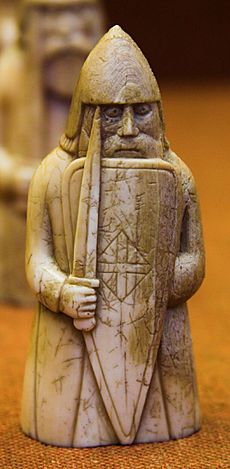
Around 1210, Norway started to show more power over the Isles. Records from Iceland say that a Norwegian army was preparing to attack the Isles in 1209. The next year, there was "warfare" in the Isles, and the holy island of Iona was attacked.

Norwegian stories say that Rǫgnvaldr and Guðrøðr had not paid their taxes to the Norwegian kings. Because of this, the Isles were attacked until both Rǫgnvaldr and Guðrøðr went to Norway. They made peace with Ingi Bárðarson, King of Norway, and promised to be loyal to him. This shows that Guðrøðr already had some power in the Isles by the early 1200s.
Family Feud Continues
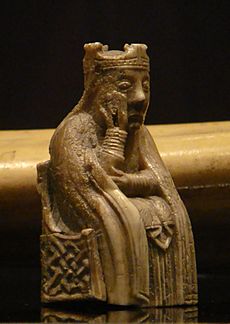
When Óláfr returned from his pilgrimage, Rǫgnvaldr arranged for him to marry "Lauon," his own wife's sister. Rǫgnvaldr gave Óláfr back the island of Lodhus. However, a bishop later said the marriage was not allowed because Óláfr had been with Lauon's cousin before. The marriage was cancelled.
This made Guðrøðr's mother (Rǫgnvaldr's wife) very angry. She tricked Guðrøðr into attacking Óláfr in 1223. Guðrøðr gathered his forces on Skye and attacked Lodhus, destroying much of the island. Óláfr barely escaped and fled to his father-in-law in Ross. Páll Bálkason, a local leader on Skye, also supported Óláfr. Later, Óláfr and Páll returned to Skye and defeated Guðrøðr in battle.
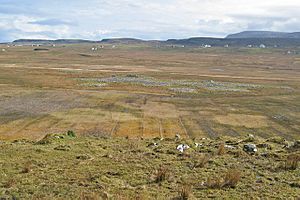
The battle took place on an island called "the isle of St Columba" on Skye. Guðrøðr's followers were killed, and Guðrøðr himself was blinded. This was a harsh punishment. Óláfr may have had help from his father-in-law in this attack.

Worsening Conflict
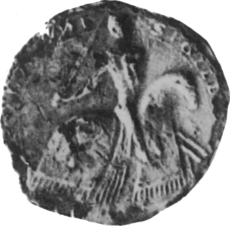
In 1224, Óláfr confronted Rǫgnvaldr on Mann. They agreed to split the kingdom: Rǫgnvaldr would keep Mann and the title of king, while Óláfr would rule parts of the Hebrides. With Óláfr gaining power, Rǫgnvaldr sought help from Alan fitz Roland, Lord of Galloway, a very powerful Scottish lord.

Around 1225 or 1226, Rǫgnvaldr arranged for his daughter to marry Alan's young son, Thomas. This marriage, however, made the people of Mann unhappy. They removed Rǫgnvaldr from power and made Óláfr king instead. The people might have worried that Alan's son would take over the kingdom, especially since Rǫgnvaldr was old and Guðrøðr was blinded. Many people likely saw Óláfr as the rightful heir.
Rǫgnvaldr went to live with Alan in Galloway. In 1228, while Óláfr was away, Rǫgnvaldr, Alan, and Alan's brother took control of Mann. Óláfr fought back and regained the island. In early 1229, Rǫgnvaldr invaded Mann again. The two half-brothers met at Tynwald Hill, where Rǫgnvaldr's forces were defeated, and Rǫgnvaldr was killed.
Norwegian Invasion
Even after Rǫgnvaldr's death, Alan and his allies continued to pressure Óláfr. News of the fighting reached Hákon Hákonarson, King of Norway, in 1229. Óláfr went to Norway in early 1230, but King Hákon had already decided what to do.

King Hákon made Óspakr the new King of the Isles. Óspakr was from the Clann Dubhghaill family and had served in Norway for a long time. Guðrøðr was one of Óspakr's main supporters. King Hákon gave Óspakr command of a large Norwegian fleet to bring peace to the Isles. Óspakr's fleet sailed to the Isles, growing bigger as it went. They met with other powerful leaders on Islay.
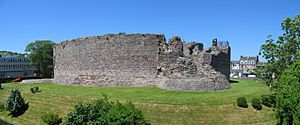
The Norwegian fleet reached the Isle of Bute and successfully captured Rothesay Castle. The castle fell after three days of fighting. The fleet was now very large, with possibly over eighty ships and more than three thousand men. However, reports that Alan fitz Roland was nearby with a huge fleet forced the Norwegians to retreat.

Óspakr became sick and died, likely from injuries he got attacking Bute. Óláfr then took command of the fleet. He managed to avoid Alan's forces and sailed to Mann. Óláfr became king of Mann again, but he had to share the kingdom with Guðrøðr, who became king of the Hebrides.

In the spring of 1231, the Norwegian forces left Mann and went home. Guðrøðr was left to rule the Hebrides. However, before the end of 1231, both Páll and Guðrøðr were killed. Guðrøðr died on Lewis and Harris.
After the Norwegians left, the fighting in the Isles started again. Guðrøðr likely took revenge on Páll, who had supported Óláfr and helped blind Guðrøðr. Óláfr then took full control of the kingdom. He ruled until his death in 1237.

Óláfr was followed by his son, Haraldr, and then another son, Rǫgnvaldr. Rǫgnvaldr was killed in 1249, possibly by someone connected to Guðrøðr's son, Haraldr. Guðrøðr's son then became king. This shows that the family feud between the lines of Rǫgnvaldr and Óláfr continued for another generation. The fighting finally ended with the last king of the dynasty, Óláfr's son, Magnús.
Images for kids



